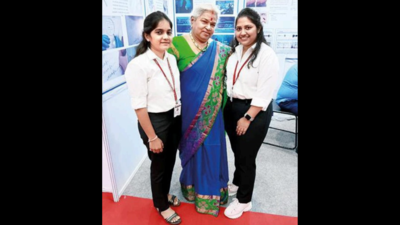Top Searches
- News
- City News
- mumbai News
- India's 1st female forensic scientist talks the walk
India's 1st female forensic scientist talks the walk

A biopic has been planned on India’s first woman forensic scientist Rukmani Krishnamurthy (centre)
"What would a lady do in FSL?" I was asked this on my first day on the job in 1974 and I resolved to prove my mettle, 74-year-old Rukmani Krishnamurthy (in pic), India's first woman forensic scientist, tells Sharmila Ganesan Ram, ahead of International Women's Day on March 8. Krishnamurthy, who has played crucial roles in the forensic investigation of the 1993 Mumbai blasts and high-profile cases such as the 2008 TV executive Neeraj Grover's murder, will soon be immortalised in a biopic.
"On the black Friday of March 12, 1993, when 12 bomb explosions shook the city, I was at Bombay Hospital where my brother was undergoing surgery. I saw victims being wheeled in. The next three months were a blur for me as the head of the explosives department when my team of 20 worked without a break," said Krishnamurthy. "I was later invited by Interpol Lyon for a discussion of the report that drew praise from global forensic scientists."
Stressing that the scope of forensics has grown in a digital world, she added: "Job opportunities have increased, but this requires exposure to all branches of science and hands-on training in real-time crime cases".
‘Used forensics for society to earn respect as scientist’
Ahead of International Women’s Day on March 8, Rukmani Krishnamurthy (74) — whose role in the forensic investigation of the 1993 Mumbai blasts and high-profile cases such as the 2008 TV executive Neeraj Grover’s murder case will soon be immortalised in a biopic — looks back on constantly having to assert, if not negotiate, her way through the worlds of men, especially as India’s first woman forensic scientist
Born in 1948, I I grew up the sixth among five sisters and two brothers in a middle-class household in Nagpur whose backbone was my mother. My father, an officer on special duty in the Madhya Pradesh government, had suffered a heart attack, after which he was advised to retire. From Raipur, our financially and emotionally hit family returned to Nagpur. My mother would drum the value of education into us, saying: “If Saraswati (goddess of knowledge) is there, Lakshmi (goddess of money) will follow.” Three appointment letters came after I secured a gold medal after my post-graduation in Chemistry: a temporary lecturer at Institute of Science in Nagpur, a clerk in Reserve Bank of India at Nagpur and an officer in Forensic Science Lab (FSL) at Bombay. I chose the last one when my father asked me to go with the one that I felt would most serve society. I would take a local train from Bhandup to Sandhurst Road as the FSL was inside JJ Hospital in 1974. On my first day on the job, my boss asked me: “What would a lady do in FSL?” I resolved to prove my mettle. Relegated to being a research assistant, I worked on a project to detect caffeine in a huge consignment of spurious cold drinks seized from railway stalls.
As my director had a meeting with the home secretary, he asked me to present the paper at a national seminar at Pune University. After sharing the technical details, I deliberately stressed the importance of the results which would nail the culprits. Then, as now, I believe that unless we connect forensics to society, we will enjoy no respect as scientists. Iheard a defence lawyer say that my MSc degree in Chemistry was a fake when I was asked to appear in court for the first case given to me for analysis: the dowry death of a bride who had been burnt with kerosene. The case history haunted me for days. When the advocate asked if kerosene in Delhi and Mumbai was the same, I turned to the judge and said: “I cannot answer this question because the defence lawyer does not know the chemical composition of kerosene”. Then, I explained how its distillation range varies as per the temperature in a particular city.
My next brush with kerosene came on February 13, 1976 — the first day I was allowed to visit a crime scene: the Matunga train fire which had killed 24. We detected traces of kerosene in the burnt debris and a halfburnt plastic container, indicating that a passenger was carrying kerosene and it must have caught fire due to a cigar bud. We advised that the authorities ban carrying inflammable articles in public transport — a rule that was immediately implemented. I chair an organisation that aims to take forensics to different sectors. There are many small institutes teaching forensics with no real exposure to handling of real-time crime cases.
National Forensic Sciences University is taking up such issues so that authentic forensic services are provided. Even as most government forensic labs are well-equipped with good infrastructure on a par with biological and analytical-grade labs, police have now realised that investigation has to take forensics into confidence. I’m tired of watching movies in which scientists take out a test tube to show DNA. Recently, we served up technical advice on crime scenes for the OTT series ‘Sacred Games’. Despite receiving 10 international and national awards, the Padma Shri still eludes me, but I’m excited to be the subject of a film.
"On the black Friday of March 12, 1993, when 12 bomb explosions shook the city, I was at Bombay Hospital where my brother was undergoing surgery. I saw victims being wheeled in. The next three months were a blur for me as the head of the explosives department when my team of 20 worked without a break," said Krishnamurthy. "I was later invited by Interpol Lyon for a discussion of the report that drew praise from global forensic scientists."
Stressing that the scope of forensics has grown in a digital world, she added: "Job opportunities have increased, but this requires exposure to all branches of science and hands-on training in real-time crime cases".
‘Used forensics for society to earn respect as scientist’
Ahead of International Women’s Day on March 8, Rukmani Krishnamurthy (74) — whose role in the forensic investigation of the 1993 Mumbai blasts and high-profile cases such as the 2008 TV executive Neeraj Grover’s murder case will soon be immortalised in a biopic — looks back on constantly having to assert, if not negotiate, her way through the worlds of men, especially as India’s first woman forensic scientist
Born in 1948, I I grew up the sixth among five sisters and two brothers in a middle-class household in Nagpur whose backbone was my mother. My father, an officer on special duty in the Madhya Pradesh government, had suffered a heart attack, after which he was advised to retire. From Raipur, our financially and emotionally hit family returned to Nagpur. My mother would drum the value of education into us, saying: “If Saraswati (goddess of knowledge) is there, Lakshmi (goddess of money) will follow.” Three appointment letters came after I secured a gold medal after my post-graduation in Chemistry: a temporary lecturer at Institute of Science in Nagpur, a clerk in Reserve Bank of India at Nagpur and an officer in Forensic Science Lab (FSL) at Bombay. I chose the last one when my father asked me to go with the one that I felt would most serve society. I would take a local train from Bhandup to Sandhurst Road as the FSL was inside JJ Hospital in 1974. On my first day on the job, my boss asked me: “What would a lady do in FSL?” I resolved to prove my mettle. Relegated to being a research assistant, I worked on a project to detect caffeine in a huge consignment of spurious cold drinks seized from railway stalls.
As my director had a meeting with the home secretary, he asked me to present the paper at a national seminar at Pune University. After sharing the technical details, I deliberately stressed the importance of the results which would nail the culprits. Then, as now, I believe that unless we connect forensics to society, we will enjoy no respect as scientists. Iheard a defence lawyer say that my MSc degree in Chemistry was a fake when I was asked to appear in court for the first case given to me for analysis: the dowry death of a bride who had been burnt with kerosene. The case history haunted me for days. When the advocate asked if kerosene in Delhi and Mumbai was the same, I turned to the judge and said: “I cannot answer this question because the defence lawyer does not know the chemical composition of kerosene”. Then, I explained how its distillation range varies as per the temperature in a particular city.
My next brush with kerosene came on February 13, 1976 — the first day I was allowed to visit a crime scene: the Matunga train fire which had killed 24. We detected traces of kerosene in the burnt debris and a halfburnt plastic container, indicating that a passenger was carrying kerosene and it must have caught fire due to a cigar bud. We advised that the authorities ban carrying inflammable articles in public transport — a rule that was immediately implemented. I chair an organisation that aims to take forensics to different sectors. There are many small institutes teaching forensics with no real exposure to handling of real-time crime cases.
National Forensic Sciences University is taking up such issues so that authentic forensic services are provided. Even as most government forensic labs are well-equipped with good infrastructure on a par with biological and analytical-grade labs, police have now realised that investigation has to take forensics into confidence. I’m tired of watching movies in which scientists take out a test tube to show DNA. Recently, we served up technical advice on crime scenes for the OTT series ‘Sacred Games’. Despite receiving 10 international and national awards, the Padma Shri still eludes me, but I’m excited to be the subject of a film.
Start a Conversation
FOLLOW US ON SOCIAL MEDIA
FacebookTwitterInstagramKOO APPYOUTUBE









